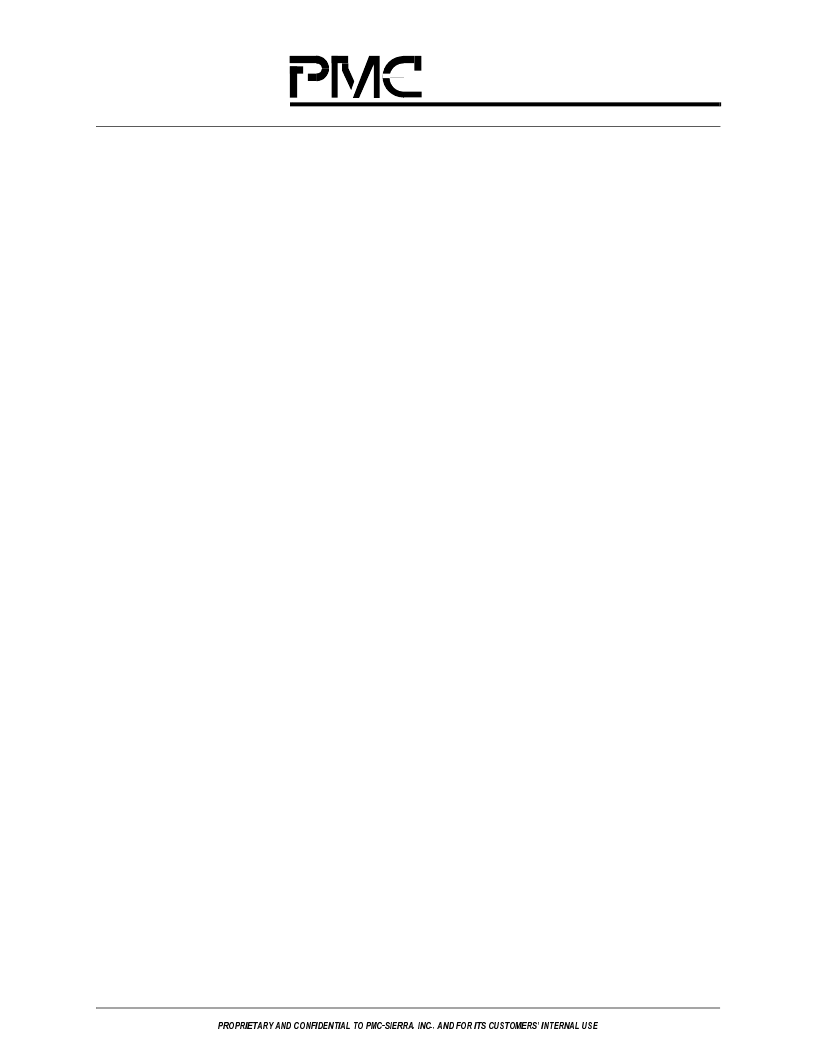- 您現(xiàn)在的位置:買賣IC網(wǎng) > PDF目錄378055 > PM73121 (PMC-SIERRA INC) AAL1 Segmentation And Reassembly Processor PDF資料下載
參數(shù)資料
| 型號: | PM73121 |
| 廠商: | PMC-SIERRA INC |
| 元件分類: | 數(shù)字傳輸電路 |
| 英文描述: | AAL1 Segmentation And Reassembly Processor |
| 中文描述: | ATM SEGMENTATION AND REASSEMBLY DEVICE |
| 文件頁數(shù): | 54/223頁 |
| 文件大小: | 2300K |
| 代理商: | PM73121 |
第1頁第2頁第3頁第4頁第5頁第6頁第7頁第8頁第9頁第10頁第11頁第12頁第13頁第14頁第15頁第16頁第17頁第18頁第19頁第20頁第21頁第22頁第23頁第24頁第25頁第26頁第27頁第28頁第29頁第30頁第31頁第32頁第33頁第34頁第35頁第36頁第37頁第38頁第39頁第40頁第41頁第42頁第43頁第44頁第45頁第46頁第47頁第48頁第49頁第50頁第51頁第52頁第53頁當前第54頁第55頁第56頁第57頁第58頁第59頁第60頁第61頁第62頁第63頁第64頁第65頁第66頁第67頁第68頁第69頁第70頁第71頁第72頁第73頁第74頁第75頁第76頁第77頁第78頁第79頁第80頁第81頁第82頁第83頁第84頁第85頁第86頁第87頁第88頁第89頁第90頁第91頁第92頁第93頁第94頁第95頁第96頁第97頁第98頁第99頁第100頁第101頁第102頁第103頁第104頁第105頁第106頁第107頁第108頁第109頁第110頁第111頁第112頁第113頁第114頁第115頁第116頁第117頁第118頁第119頁第120頁第121頁第122頁第123頁第124頁第125頁第126頁第127頁第128頁第129頁第130頁第131頁第132頁第133頁第134頁第135頁第136頁第137頁第138頁第139頁第140頁第141頁第142頁第143頁第144頁第145頁第146頁第147頁第148頁第149頁第150頁第151頁第152頁第153頁第154頁第155頁第156頁第157頁第158頁第159頁第160頁第161頁第162頁第163頁第164頁第165頁第166頁第167頁第168頁第169頁第170頁第171頁第172頁第173頁第174頁第175頁第176頁第177頁第178頁第179頁第180頁第181頁第182頁第183頁第184頁第185頁第186頁第187頁第188頁第189頁第190頁第191頁第192頁第193頁第194頁第195頁第196頁第197頁第198頁第199頁第200頁第201頁第202頁第203頁第204頁第205頁第206頁第207頁第208頁第209頁第210頁第211頁第212頁第213頁第214頁第215頁第216頁第217頁第218頁第219頁第220頁第221頁第222頁第223頁

PM73121AAL1gator II
PMC-Sierra, Inc.
L
PMC-980620
,VVXH
AAL1 SAR Processor
Data Sheet
35235,(7$5<$1'&21),'(17,$/7230&6,(55$,1&$1')25,76&86720(56,17(51$/86(
3.2.1
Transmit CDV
The following items affect transmit CDV:
Cell scheduling,
Contention with other cells scheduled at same time,
Actual cell build time, and
UTOPIA contention.
1. The scheduler has a resolution of 125 μs. In other words, it works off a frame-based clock to
determine whether or not a cell should be sent during the current frame. Therefore, if the ideal
rate of cell transmission is not a multiple of 125 μs, there will be 125 μs of CDV. The sched-
uler will never add more than 125 μs of CDV.
For example, a single DS0 queue with no signaling and using full cells, will need to build a
cell every 47 frames. Therefore, a cell will be scheduled every 47 frames, and the scheduler
will add no CDV.
However, if signaling were added to the single DS0 queue, the extra byte that occurs every 24
bytes (assuming T1 mode) requires compensation. In this case, a cell will be sent every 46 or
47 frames. Therefore, there will be 125 μs of CDV due to the scheduler.
2. Only one cell can be built at a time. Thus if multiple queues are scheduled to send cells during
the same frame, additional CDV will be incurred. Since it takes approximately 8 μs to build a
cell, each cell that is waited for adds 8 μs of delay. When multiple queues are scheduled to
send cells at the same time, the cells will be built in sequential order, starting with 0 and going
to 256. Therefore, in a system that will be adding and dropping queues, the higher number
queues will experience more CDV than the lower number queues, depending on how many
queues are active at the time, and are scheduled within the same frame. Theoretically, it is
possible to have all 256 queues scheduled at the same time, however, this will not occur if
adequate steps are taken.
Minimize CDV due to clumping by the following actions:
Add queues one at a time (PMC-Sierra’s driver does this automatically). When queues are
added at the same time with the same configuration, they are clumped together. By adding
queues one at a time, clumping can be avoided and cell scheduling points can be evenly dis-
tributed. Also, queues are only added in frame 0. Since the transmit buffer is 128 frames (for
E1) or 96 frames (for T1), this equates to 16 ms (for E1) or 12 ms (for T1). Queues should be
added more than 16 ms apart (for E1) or 12 ms (for T1) to prevent them from being clumped
together.
Avoid configurations that will require sending a cell every
n
frames where
n
is an integer divi-
相關PDF資料 |
PDF描述 |
|---|---|
| PM73121-RI | AAL1 Segmentation And Reassembly Processor |
| PM73122 | 32 LINK CES/DBCES AAL1 SAR PROCESSOR |
| PM73122-BI | 32 LINK CES/DBCES AAL1 SAR PROCESSOR |
| PM73123 | 8 LINK CES/DBCES AAL1 SAR |
| PM73123-PI | 8 LINK CES/DBCES AAL1 SAR |
相關代理商/技術參數(shù) |
參數(shù)描述 |
|---|---|
| PM73121-RI | 制造商:PMC 制造商全稱:PMC 功能描述:AAL1 Segmentation And Reassembly Processor |
| PM73122 | 制造商:PMC 制造商全稱:PMC 功能描述:32 LINK CES/DBCES AAL1 SAR PROCESSOR |
| PM73122-BI | 制造商:PMC 制造商全稱:PMC 功能描述:32 LINK CES/DBCES AAL1 SAR PROCESSOR |
發(fā)布緊急采購,3分鐘左右您將得到回復。